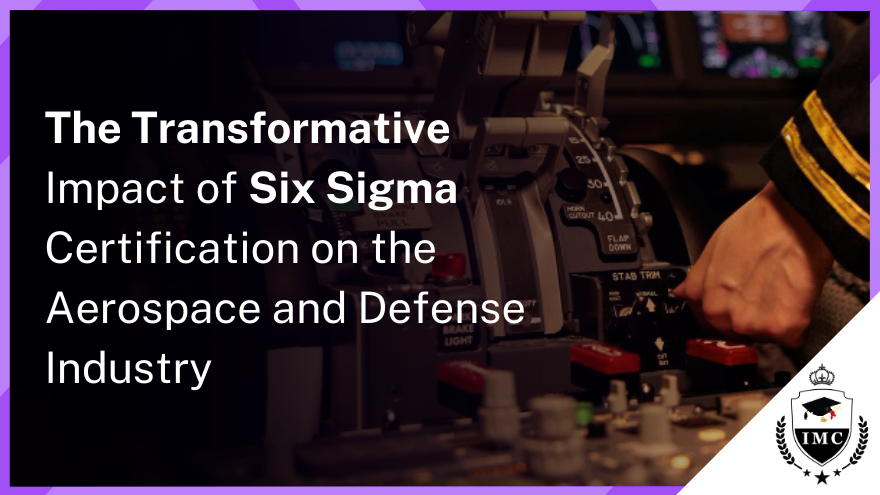Six Sigma, a data-driven methodology for continuous improvement, is revolutionizing the aerospace industry by optimizing processes, enhancing efficiency, and delivering superior products and services. In the aerospace and defense industries, Six Sigma certification is a game-changer. This blog explores how Six Sigma, a data-driven approach for continuous improvement, is making waves in these sectors. From enhancing product quality and streamlining processes to meeting stringent regulatory standards, Six Sigma certification is the key to success in aerospace and defense. We'll also highlight the benefits for professionals, the certification levels, and why it's a critical asset for those aspiring to excel in these high-stakes fields. Within the aerospace and defense sectors, professionals pursue Six Sigma certification at different levels, each denoted by a specific "belts" The Six Sigma Green Belt Certification signifies a comprehensive understanding of quality management principles, while the Six Sigma Black Belt Certification represents advanced expertise in statistical methods and optimization techniques. At the pinnacle, the Six Sigma Master Black Belt Certification requires unparalleled proficiency, marking individuals as leaders in driving continuous improvement initiatives within the aerospace and defense landscapes. Join us as we unravel the impact of Six Sigma on precision, efficiency, and excellence in aerospace and defense.
The Integral Role of Six Sigma in Aerospace:
Enhance Product Quality:
By identifying and eliminating defects, Six Sigma ensures the reliability, safety, and performance of aerospace products, aligning with the industry's commitment to excellence.
Optimize Process Efficiency:
Streamlining operations and resource utilization through Six Sigma principles leads to improved productivity, reduced costs, and heightened operational efficiency, crucial in a sector driven by precision and innovation.
Drive Continuous Improvement:
A culture of continuous improvement is fostered as organizations analyze processes, identify areas for enhancement, and implement sustainable solutions, keeping pace with evolving industry demands.
Ensure Regulatory Compliance:
Six Sigma Certification serves as a testament to an organization's commitment to meeting stringent regulatory requirements, vital in an industry governed by entities like the FAA and the Department of Defense. Cultivate a Quality-Focused Culture: Six Sigma instills a culture of quality, empowering employees to take ownership, prioritize customer satisfaction, and actively contribute to ongoing improvement initiatives.
Overview of the Aerospace Industry:
The aerospace industry, a multifaceted sector encompassing aircraft and spacecraft design, development, manufacturing, and maintenance, is a linchpin of the global economy. Comprising both large multinational corporations and nimble SMEs, the industry boasts a highly skilled workforce engaged in diverse fields such as engineering, design, and maintenance. Amidst evolving trends and challenges, including heightened competition, demands for efficiency, sustainability, and sophisticated military aircraft, the aerospace sector stands at the forefront of technological advancements and market dynamics.
Six Sigma in Aerospace:
Six Sigma, a quality management methodology wielding statistical tools, is a linchpin in aerospace, permeating manufacturing, Supply chain management, and customer satisfaction initiatives. Aerospace companies leverage Six Sigma to reduce waste, bolster profitability, and deliver high-quality products. This methodology finds application across various facets of the aerospace industry, from aircraft production to maintenance and support services, all with the overarching goal of providing safe, reliable products while ensuring continuous improvement.
The Crucial Role of Six Sigma in Aerospace:
In the aerospace industry, where precision and reliability are paramount, Six Sigma assumes a critical role in identifying and eliminating sources of variation and error. By employing Six Sigma tools and techniques, aerospace companies enhance efficiency, increase customer satisfaction, and gain a competitive edge. Compliance with stringent regulations, such as those set by the Federal Aviation Administration (FAA), is facilitated through the meticulous application of Six Sigma principles, ensuring that safety and reliability remain non-negotiable.
Enhancing Efficiency and Reducing Costs:
The primary objective of Six Sigma in aerospace is to boost efficiency and cut costs by addressing defects and minimizing waste through data-driven methods and statistical analysis. The methodology empowers aerospace companies to streamline processes, reduce errors, and elevate overall quality. Beyond mere compliance, Six Sigma becomes a catalyst for improved competitiveness, as efficiency gains and cost reductions propel aerospace companies toward sustained success.
The Role of Six Sigma in Improving Quality and Efficiency in Defense Organizations:
The defense industry's pivotal role in safeguarding nations necessitates a relentless pursuit of efficiency and quality. Six Sigma emerges as a crucial ally, employing data-driven methodologies to improve processes, reduce costs, and ensure the safety and security of nations. This section underscores how Six Sigma's principles align seamlessly with the stringent demands of the defense industry, emphasizing continuous improvement, data-driven decision-making, and compliance with regulations.
Steps to Obtaining Six Sigma Certification in Defense Industry:
For professionals aspiring to acquire Six Sigma Certification in the defense sector, a structured approach is imperative. This section outlines a step-by-step guide, from familiarizing oneself with the methodology to choosing a certification body, completing training, passing the certification exam, gaining on-the-job experience, and maintaining certification. By following these steps, individuals can demonstrate their expertise in improving process efficiency and customer satisfaction within the defense industry.
Six Sigma Certification Levels and Requirements in Defense:
The journey to Six Sigma excellence in the defense industry involves navigating through different certification levels – White Belt,Six Sigma Yellow Belt , Six Sigma Green Belt Certification Six Sigma Black Belt Certification, and Six Sigma Master Black Belt Certification. Each level demands a specific set of knowledge, training, and experience, with the highest level requiring advanced expertise. Individuals seeking Six Sigma certification in defense may encounter additional prerequisites, such as security clearances or specialized training, tailored to their roles and organizational needs. This section provides a comprehensive overview of these levels, requirements, and the tangible benefits of obtaining Six Sigma Certification in the defense sector.
The Benefits of Six Sigma Certification for Defense Professionals:
Expanded Career Opportunities:
Opens doors to advancement, leadership roles, and specialized positions in aerospace and defense. Reflects expertise in quality management and data-driven decision-making. Deepened Industry Knowledge: Comprehensive understanding of quality management principles. Mastery of statistical methods and optimization techniques for informed decision-making.
Enhanced Problem-Solving Skills:
Structured problem-solving approach. Ability to identify root causes, analyze data, and develop effective solutions. Addresses complex challenges in aerospace and defense projects.
Strengthened Leadership Capabilities:
Preparation for leadership roles. Fosters skills in team building, project management, and change management. Essential for steering quality improvement initiatives to success.
Global Recognition:
Recognized globally as a symbol of quality and process excellence. Provides a competitive edge in the international aerospace and defense market.
Improved Processes and Increased Efficiency (Defense):
Data-driven approach and statistical analysis identify and eliminate defects. Streamlined processes lead to heightened efficiency and reduced waste. More effective goal achievement, benefiting end-users. Increased Competitiveness (Defense): Continuous improvement through Six Sigma ensures defense organizations stay ahead of the competition. Results in increased market share, profitability, and a stellar reputation.
Career Advancement Opportunities (Defense):
Highly valued in the defense sector, opening doors to career advancement. Professionals equipped with Six Sigma skills are sought after by organizations. Better Quality and Customer Satisfaction (Defense): Six Sigma's focus on defect reduction translates into better-quality products and services. Leads to increased customer satisfaction and an enhanced organizational reputation.
The Benefits of Six Sigma Certification in Defense:
Career Prospects and Salary:
Career Prospects:
Six Sigma professionals in defense can thrive in roles such as process improvement specialists, quality engineers, and project managers. They actively contribute to implementing and maintaining Six Sigma methodologies, leading process improvement projects, and designing innovative defense solutions.
Salary Insights:
According to Glassdoor, the average salary for a Six Sigma Black Belt in the defense industry is approximately $100,000 annually. Salaries can vary based on experience, education, and job responsibilities, with higher-level certifications like Master Black Belt commanding even greater earning potential.
The Future of Six Sigma in Aerospace:
As the aerospace industry evolves and confronts new challenges, Six Sigma's future remains bright. The industry's commitment to high standards aligns seamlessly with Six Sigma's data-driven decision-making and continuous improvement ethos, making it an integral part of operations. With technology advancing, data and analytics will play an increasingly vital role, positioning Six Sigma as a valuable methodology for analyzing and enhancing processes. In an era of escalating competition and rising customer expectations, Six Sigma emerges as a structured and proven approach to identify waste, improve efficiency, and maintain a competitive edge. Its adoption will likely surge, contributing to the aerospace industry's ability to innovate and thrive.
In Summary,
Six Sigma has made a huge difference in the aerospace industry. Big companies like Boeing, GE Aerospace, Honeywell Aerospace, and Airbus have seen significant improvements in how they work, cutting waste, and making better products, thanks to Six Sigma This method, with its focus on using data and always getting better, has helped these companies reach new heights in the aerospace world. Looking ahead, Six Sigma is likely to become even more important. In a time where competition is tough, and customers expect a lot, Six Sigma provides a structured and proven way to improve efficiency and stay ahead. Its popularity is expected to grow, helping the aerospace industry keep up the innovation and success. To put it simply, Six Sigma isn't just successful – it's become a crucial partner in making the aerospace industry excellent. Its commitment to quality and always trying to do better fits perfectly with the high standards of the aerospace world, making it a lasting and valuable tool for those aiming for success in this dynamic field.






